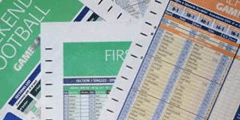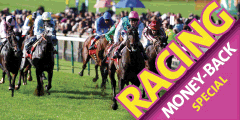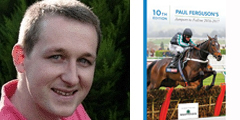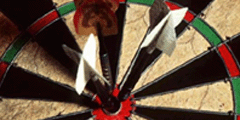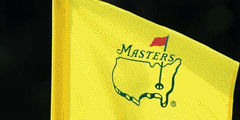Online betting has revolutionised the industry, but for the pro’s and the old-timers, there’s still only one place to be – on-course, in the betting ring. Simon Nott joins the throng.
It’s the sort of glorious scene that makes punting on horses the occupation that it is.
There’s a scrum of punters, the shrewd and the desperate alike, ready to feed their betting craving with tenners clutched in nicotine-stained fingers. Amid the hustle and bustle, the bookies are barking the bets; prices are rubbed as the off-course reps attempt to shorten a horse by calling in a bottomless pit of bets down the line. There’s a scrum as a steely bookmaker decides to stick his chest out and stand one for his maximum. Over by the rails, there’s almost literally a knock over, as the shrewdies descend on a bookmaker who’s chalked up an opening show that they reckon is off the mark.
Yep, regardless of the multiple betting opportunities available to the modern day punter, there’s still only one place to be if you’re serious about making money punting on horses. The betting ring. Even if you knew nothing about horses it’d be impossible to avoid getting caught up in the drama. To the trained eye, moreover, all you need to point you towards the next winner is unfolding right in front of you.
We may live in the internet age, but the appearance of one ‘face’ at a bookmaker’s pitch can still be enough to affect the whole market, even if only a modest amount of money’s invested. From the betting ring, the astute punter can see where the sharp money is going, having just seen for himself the condition of the horses in the paddock.
Who’s Who in the Ring?
The mainstays of the betting ring are the bookies. They divide into rails bookies and tattersalls operators. They are a mixed bunch and it pays to sort out who is who as early as possible in your racecourse punting career.
Until recently there was a mystique about the rails guys. This row of sharp-suited geezers, who stood at the rail between the tattersalls and members’ enclosures, were traditionally not allowed to show prices. The odd one would shout the odds, but the others would stand in a dignified silence, waiting for clients to request a price. It’s common belief that this was where all the lumpy action took place, and – although there were boards books that would put a few of the rails operators to shame – that was broadly true.
Trainers and owners would discreetly have their bets with their favourite bookies, cards would be marked, phone calls would go back to head office and, on instruction, significant business would be sent into tatts. Some of the rails bookmakers gained near-legendary status, with ‘monster bets’ being laid and hysterically reported on the TV.
These days though, with boards on the rails, it’s no longer the sole domain of the big hitter. Many small tattersalls bookies have set up pitches on the rails, advertising modest maximum wagers. Rails bookies now are pretty much just an extension of the tattersalls, although generally speaking, rails hedging money is very live, so it pays to recognise and look out for the rails floor men.
Also frequently found scurrying around the rails operators are floor men for the Big Three and other off-course shrewd firms.
They get sent into the ring for one reason, and that’s to shorten horses up. Different firms have different reasons for backing horses. Some are just hedging money on horses popular in the shops, for example a Frankie Dettori favourite after he’s had a treble.
If lots of shrewd money is going in, the reps will be sent into the main ring to smash up the prices on the horses where the smart money’s going. Obviously this is important to you: if you were waiting to get a price bigger than that on offer, you need to get in front of the reps, as the price will collapse around your ears on a quiet day and shorten even on a busy one. Alternatively, if you were undecided, the money coming in from off course may sway you, as it means someone well respected is having it on – but beware the Frankie factor!
Tatt’s Entertainment
The other bookies to be found in the betting ring are those over by the tattersalls. You would be hard pressed to find a more diverse and colourful selection of characters than the tatts bookies. Though a lot of the old legends have shuffled off of this mortal coil – or at least retired to the seaside – there are enough left to fill several novels. Most are gentlemen, some are not, though none are the ‘dastardly bookmakers’ of popular infamy. Their business is based around honesty – they’re there to win your money, not to steal it.
A floor man for the most modest of tatts bookmakers will have bets over a year going into tens if not hundreds of thousands of pounds. They’re placed by word of mouth and sometimes, though rarer these days, tic-tac signals.
Tatts floor men, like their rails counterparts, should be watched like hawks. They will probably be wired up, and aware of price movements before you are. If they start to move in to rub prices or hedge, then you want to get in front of them. Only experience will tell you which floor men to watch – you need to get a feel for the ring and the movements within it.
Experience is also the key to spotting ‘faces’ – respected pro punters and exchange arbsters. When they make a move, this should also mark your card as to what is fancied and will shorten. Getting the right price is what on-course betting is all about, so keep your eyes and ears open.
Tricks of the Trade
Quite often bookmakers will call bets in-running. You will normally have to be there with your money in hand to get on, unless the bookmaker knows you. Some bookies can’t resist giving away money if a result looks on the cards, so if a 33/1 shot looks as if it’s going to turn over the favourite with three to jump, you would do well to position yourself next to your man as the horse approaches the last, in anticipation of him shouting ‘take 2/1.’ That way – wallop – you’re on the spot to get on.
The books are honest, but they still have a few little tricks that you should watch out for. It happens much less often these days, with almost instant photo finish results, but a few books will brave the frowns of the punters to price the obvious second in such a finish at 1/3, in the hope of tempting in a mug who bets before he thinks. It’s a case of ‘buyer beware’ – if you bet the wrong horse, it’s irrelevant what you ‘meant’ to do, so be warned.
Such practices may seem underhand, but they’re all part of the rich pageant of the betting ring. The betting opportunities and nods in the right direction are all there to be seen by those who know to look. Hunt for value and the game is all but won!


